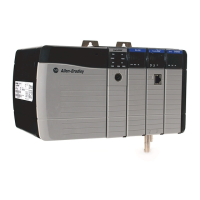Rockwell Automation Publication 1756-RM003N-EN-P - October 2011 157
Input/Output Instructions (MSG, GSV, SSV, IOT) Chapter 4
Mnemonic Data
Type
Description
.FLAGS INT The FLAGS member provides access to the status members (bits) in one 16-bit word.
This bit Is this member
2.EW
4.ER
5.DN
6.ST
7.EN
8.TO
9 .EN_CC
Important: Do not change or manipulate the EN, EW, ER, DN, or ST bits of the FLAGS member. For example, do
not clear the entire FLAGS word. The controller ignores the change and uses the internally-stored values of the
bits.
.ERR INT If the .ER bit is set, the error code word identifies error codes for the MSG instruction. Manipulating these bits
can cause an unrecoverable major fault in the controller. See MSG Error Codes
on page 165.
.EXERR INT The extended error code word specifies additional error code information for some error codes. See Extended
Error Codes on page 167.
.REQ_LEN INT The requested length specifies how many words the message instruction will attempt to transfer.
.DN_LEN INT The done length identifies how many words actually transferred.
.EW BOOL The enable waiting bit is set when the controller detects that a message request has entered the queue. The
controller resets the .EW bit when the .ST bit is set.
Important: Do not change or manipulate the EW bit. The controller ignores the change and uses the internally-
stored value of the bit. Manipulating these bits can cause an unrecoverable major fault in the controller.
.ER BOOL The error bit is set when the controller detects that a transfer failed. The .ER bit is reset the next time the rung-
condition-in goes from false to true.
Important: Do not change or manipulate the ER bit. Manipulating these bits can cause an unrecoverable major
fault in the controller.
.DN BOOL The done bit is set when the last packet of the message is successfully transferred. The .DN bit is reset the next
time the rung-condition-in goes from false to true.
Important: Do not change or manipulate the DN bit. Manipulating these bits can cause an unrecoverable major
fault in the controller.
.ST BOOL The start bit is set when the controller begins executing the MSG instruction. The .ST bit is reset when the .DN
bit or the .ER bit is set.
Important: Do not change or manipulate the ST bit. The controller ignores the change and uses the internally-
stored value of the bit. Manipulating these bits can cause an unrecoverable major fault in the controller.
.EN BOOL The enable bit is set when the rung-condition-in goes true and remains set until either the .DN bit or the .ER bit
is set and the rung-condition-in is false. If the rung-condition-in goes false, but the .DN bit and the .ER bit are
cleared, the .EN bit remains set.
Important: Do not change or manipulate the EN bit. Manipulating these bits can cause an unrecoverable major
fault in the controller.
.TO BOOL If you manually set the .TO bit, the controller stops processing the message and sets the .ER bit.
.EN_CC BOOL The enable cache bit determines how to manage the MSG connection. Refer to
Choose a Cache Option on
page 191 Connections for MSG instructions going out the serial port are not cached, even if the .EN_CC bit is
set.
.ERR_SRC SINT Used by RSLogix 5000 software to show the error path on the Message Configuration dialog box
.DestinationLink INT To change the Destination Link of a DH+ or CIP with Source ID message, set this member to the required value.
.DestinationNode INT To change the Destination Node of a DH+ or CIP with Source ID message, set this member to the required value.
.SourceLink INT To change the Source Link of a DH+ or CIP with Source ID message, set this member to the required value.

